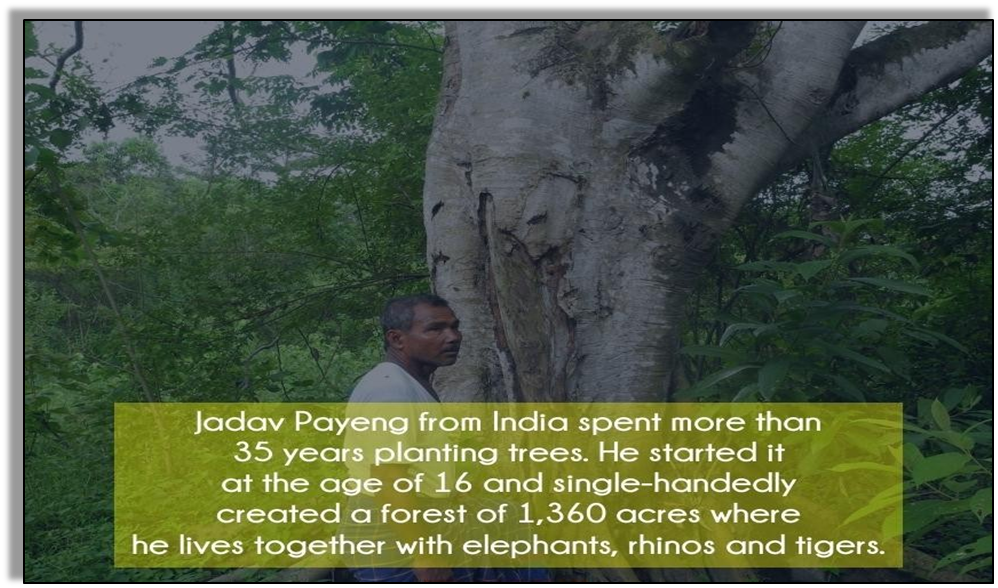- Books Name
- Class-8 Science Book
- Publication
- PathSet Publications
- Course
- CBSE Class 8
- Subject
- Science
Reforestation
Restocking of the destroyed forest is called Reforestation. In easy language, it means planting more trees to replace the old ones which have been cut or died Reforestation can also happen naturally if we keep deforested areas undisturbed.
Benefits of Reforestation
- It will prevent global warming
- It will reduce pollution
- It will prevent droughts and floods and maintain the water cycle
- Forest Products like wood will be available to us in sufficient quantity
Reforestation is the opposite of deforestation. Here, we plant new trees to restock forests that have been destroyed. In India, we have the Forest (Conservation) Act which aims to preserve and conserve natural forests and meet the basic needs of the people living in or near them.
Reforestation can happen naturally or can be done artificially. If a deforested area is left undisturbed for some time, the forests grow again. However, we cut more trees than the ones that grow on their own and hence, we should plant trees to promote reforestation. Ideally, we should plant as many trees as had been cut down and the new trees should be of the same species as the earlier ones.
Padma Shri Jadav 'Molai' Payeng, the Forest Man of India is an environmental activist and forestry worker. He is from Jorhat, India, and single-handedly planted and nurtured a forest encompassing an area of 1,360 hectares across several decades along the sandbar of the River Brahmaputra. He was awarded Padma Shri - the fourth highest civilian award in India - in 2015 for the feat. The forest he planted is called 'Molai forest' after him.

Important Terms
- Wildlife Conservation is the practice of protecting endangered plant-animal species and their habitats to maintain the ecological balance.
- Deforestation is the process of clearing forests in order to use the land for timber, industrial, agricultural, and other purposes.
- Biosphere Reserve: Biosphere reserves are the areas meant for the conservation of biodiversity. The biosphere reserves help to maintain the biodiversity and culture of that area.
- Flora and fauna: The plants and animals found in a particular area are termed flora and fauna respectively of that area.
- Species: it is a group of populations that are capable of interbreeding to reproduce fertile offspring.
- Endemic species: Species of plants and animals which are found exclusively in a particular area and are not naturally found anywhere else. E.g., sal and wild mango
- Wildlife Sanctuaries: Sanctuaries like reserve forests provide protection and suitable living conditions to wild animals. Killing, poaching, or capturing animals, in general, is strictly prohibited and punishable by law in all such places.
- National Park: these are large and diverse areas enough to protect whole sets of ecosystems. They preserve flora, fauna, landscape, and historic objects of an area.
- Project Tiger: It was launched by the government to protect the tigers in the country. The objective was to ensure the survival and maintenance of the tiger population in the country.
- Endangered species: the species whose numbers are diminishing to a level that they might face extinction are known as endangered animals.
- Ecosystem: An ecosystem is made of all the plants, animals, and microorganisms in an area along with non-living components such as soil, river etc.
- Red Data Book: This book is the sourcebook that keeps a record of all the endangered animals and plants. Red Data Book is maintained internationally by an organization.
- Migratory birds: Birds who cover long distances to reach another land are known as migratory birds. These birds fly for laying eggs as the weather in their natural habitat becomes unsuitable
- Paper recycling: Generally, paper can be recycled in the five to seventies for use. One can save, reuse used paper and recycle it. It also helps us to save energy and water needed for manufacturing paper.
- Reforestation: It is the restocking of the destroyed forests by planting new trees. Generally, the same species which were found in that forest are replanted. Plant at least the same number of trees we cut. Reforestation can take place naturally if the deforested area is left undisturbed, it reestablishes itself.
- The Forest Conservation Act: The act aims at the preservation and conservation of natural forests and meeting the basic needs of the people living in or near the forests.

 PathSet Publications
PathSet Publications
